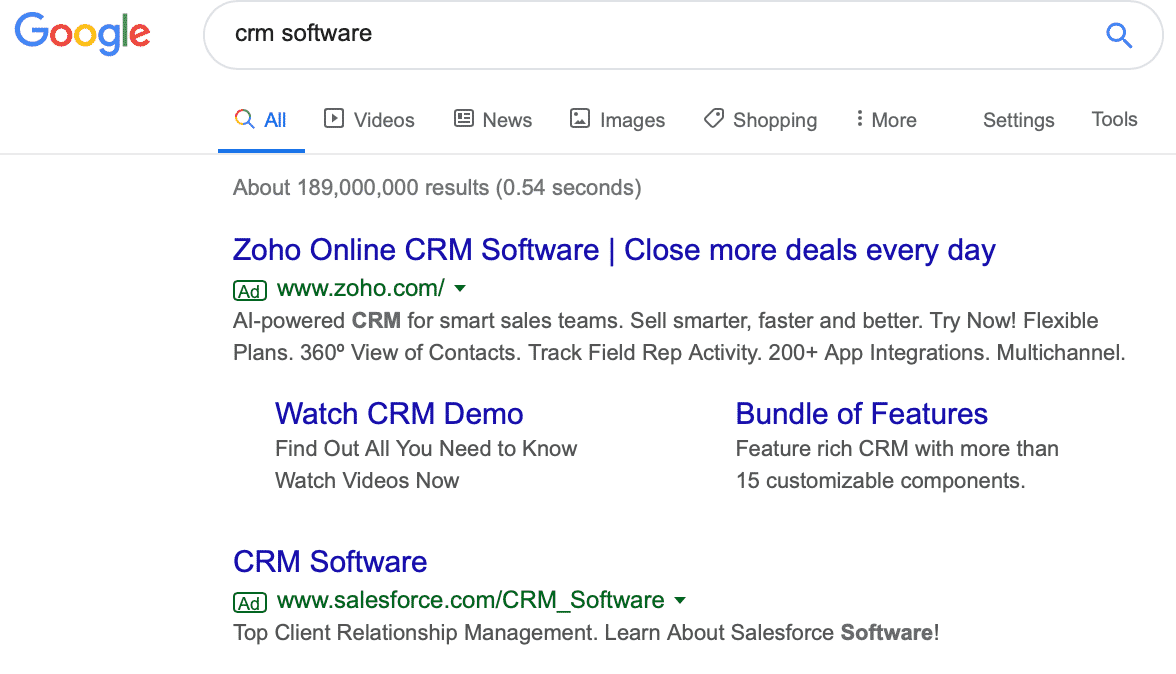8 PPC Mistakes Companies Make When Running B2B Campaigns
by Ana Gotter • October 17, 2019
Pay-per-click (PPC) advertising is one of the most popular methods of marketing online, allowing brands to leverage ad spend and bids to connect with their target audience on a massive scale.
B2B businesses are able to use these campaigns to run hyper-targeted, niche campaigns that are designed to establish brand awareness, position yourself as a top-quality tool, and hopefully eventually drive sales from your target audience.
It’s a pretty straightforward concept, but of course, the execution can be a little more challenging. There are so many platforms to choose from, each one more complex than the last, and there are so many options for ad format, keyword groups, copy creation, creatives, and more that it’s no surprise some B2B brands are struggling to get the results they hoped to see.
When setting up their ads, there are 8 common B2B PPC mistakes, and in this post, we’re going to take a look at each one and how to avoid it.
1. They Treat It the Same as a B2C Campaign
B2B and B2C campaigns do have some overlap, and many of the same basic best practices apply; you want tight keyword groups, you need to get your targeting right, and short, concise copy is always best.
That being said, there are major differences in B2B and B2C PPC advertising.
It’s important to understand those differences, especially considering so many blog posts about PPC are geared towards B2C advertisers. They include:
- The buying process is typically longer for B2B buyers, with more research involved and a lot more consideration going into how the product, brand, or service will affect their bottom line. There isn’t nearly as much impulse buying happening here, so be prepared for the buying process to take longer. Adjust any acquisition windows accordingly, and set up multiple touchpoints to take this into account.
- B2B buyers are more focused on logic and data. This is a general stereotype, but it’s often an effective one. While B2B buyers are absolutely still impacted by relevant emotional appeals, you have to really go after the logical, data-based approach here.
- B2B marketing may require you to convince a group, not a single individual. If I see an ad today for a new perfume and decide “hey, ordering something scented online that I’ve never smelled before seems like a great idea,” then I can absolutely choose to throw away $100 on some random bottle of terrible smelling perfume. All I’d need is an impulse to do so and a credit card nearby.
B2B marketing, however, may require multiple individuals to agree, including the individual managing the budget, the office manager, the marketing director, the C-level executives, and on and on. It depends on what you’re selling, but you may need the approval of more than one person here.
2. Failing to Take Funnel Stage Into Account
When you’re setting up your ad campaigns, are you considering what stage of the buyer’s process the user seeing your ads will be in?
Someone who is searching for “automated scheduling software,” for example, is much further along than someone who has no idea that such a thing exists before they happen to stumble across your ad on Facebook. If you’re selling too aggressively to a cold audience, they’ll mentally check out and you’ll struggle to get those conversions.
Certain campaigns will draw users who are earlier or later in the funnel, and you need to adapt accordingly. If you’re running discovery ads on platforms like Facebook or LinkedIn, for example, you may be more effective if you push for lead information with offers of a free trial, free consultation, or a lead magnet instead of trying to push for a sale right away.
3. Choosing the Wrong Platforms
Pinterest is great for fun, visual, physical goods that are B2C-focused. If you want to sell gourmet dog treats or hand-knitted children’s Halloween costumes, this is your place. B2B businesses, on the other hand, often struggle here.
Easily the strongest platforms for B2B businesses are Google Ads, LinkedIn Ads, and Bing Ads. Facebook can work well, but it’s often most successful for B2C advertisers.
In addition to choosing the right platforms, you’ll want to ensure you’re dividing up your ad spend correctly. Google Ads, for example, does hold a larger share of search traffic, but Bing can deliver just-as-good clicks and conversions at a significantly lower cost thanks to the lower competition levels. You can often maximize your ad spend by dividing it up between different platforms, expanding reach while lowering costs. This will require some testing, but it’s well worth the effort.
4. Using Stiff, Esoteric Language
You’re selling to professionals, and you yourself are an expert at what you do. That’s excellent, but you still need to be careful to write approachable, easy-to-read copy that doesn’t get too niched down that it isolates your target audience. This means avoiding stiff, esoteric language; just because you’re an expert doesn’t mean you can’t talk like a human being.
Let’s look at an example. Here, we see two companies who have bid on the keyword “CRM software.” Both ads are using friendly and easy-to-understand language that will help all customers quickly understand what makes each one valuable.

They aren’t using terms like “CLV analytics, maximize ROAS”—even though they could. They’re talking about “Sell smarter, faster, and better” and “feature-rich.” These are benefits anyone can see the appeal of, which makes their ad more effective.
5. Keeping The Same Successful Campaigns Running on Autopilot
This is probably the easiest B2B PPC mistake that brands can fall into without even realizing it, especially since their services, products, or offerings may not change as quickly as their B2C counterparts.
It’s tempting, therefore, to keep a single, high-performing campaign running on autopilot after you’ve gotten strong results the first go around. It landed plenty of conversions before, so why fix what’s not broken, right?
Unfortunately, this just isn’t how PPC campaigns work for several reasons.
If you have the same ad running and are targeting the same audience, for starters, you’ll likely end up running a high frequency, meaning that the same users start seeing the ad again and again. If they didn’t convert the first time, they definitely won’t on the eighth or ninth or fiftieth. You need fresh content to keep your audience engaged and hopefully purchasing.
It’s also common for trends to change over time. Keywords, for example, might rise in popularity and in cost/competitiveness, while others may fall by the wayside and result in you seeing a significant decrease in traffic and potential placements.
You need to watch your campaigns carefully, ensuring that they’re getting enough traction and at a low enough cost. This can all fluctuate quickly, so monitoring your campaigns at least once per week is a good call.
6. Not Leveraging Retargeting
Almost all PPC platforms are going to have some form of retargeting option, and if you aren’t using it, you’re likely leaving a lot of money on the table while you essentially wave goodbye to your customers.
Retargeting allows you to reconnect with users who have engaged with your business in some way in the past. If someone were to fill out a lead form on LinkedIn, for example, you don’t just want them to drop off and have that be it. You can create a retargeting campaign that then shows them an exclusive offer for a discount or free trial, moving them to the next stage of the digital sales funnel.
We recommend having retargeting campaigns set up from the get-go, giving you a semi-automatic funnel that can be adjusted at any point.
7. Linking to Landing Pages With No Contact Options
Someone comes to your landing page. They’re ready to get in touch to learn more, because they have questions or want to find out about which service or product would be best for them. But here’s the catch: They can’t, because you don’t have clear contact options on your site.
This happens more often then you think, but it’s a simple fix, so don’t let it be you. Include a clickable, mobile-friendly phone number in the top corner of your page, and always include a contact form on every landing page, even if it’s short.
This gives people a way to get in touch quickly in whatever way is most comfortable for them; some will prefer to call, but increasing numbers of users (particularly younger, Millennial-and-under users) will want to see online options that are fast and convenient.
8. Not Understanding Their Target Audience for Each Campaign
Let’s say that I’m selling running shoes. I run an ad promoting running shoes, targeting runners and athletes with my ad campaigns. The individual who would be using the product can see it, decide it’s right for them, and purchase. They might have to run it by a spouse, but that’s about it. I’m marketing directly to the consumer who will both purchase and use the product.
B2B PPC mistakes happen, however, when you get busy creating campaigns that appeal to the individuals using the products instead of those who will actually decide whether or not that purchase will ever happen. When I worked at Disney, for example, I was given a pair of black, non-slip shoes. I was the one who wore them, but I had no choice in the matter as to the brand or design—that was all chosen by someone up much, much higher than I was.
Consider the decision-maker and what motivates them. For Disney, that would be the costume designers and likely high-up executives. They didn’t care so much about fashion as they did safety and cost-effectiveness for the company. Knowing which pain points and appeals to use for different decision-makers will be key, and it will allow you to target them most effectively.
Final Thoughts
PPC campaigns can be a potential goldmine for B2B businesses, but only if you’re setting them up for success and avoiding any of the common B2B PPC mistakes that we’ve detailed above.
If you’ve started to run your PPC campaigns and aren’t quite getting the results that you want the first time around, remember that testing is almost always needed for ad campaigns. You have to test what works for your business and your audience, and that may mean testing multiple strategies or targeting options on one platform or testing out multiple different platforms to see what sticks. This is normal, so use small portions of your budget to run ongoing tests even once you think you’ve cracked the code.
Need some help setting up your campaigns, managing your ads, or even auditing your existing strategies to see what’s best for your business? Learn more about what we can do for you here!
What do you think? Have you ever run into any of these 8 common B2B PPC mistakes? Which do you think would be most detrimental to your campaigns? Share your thoughts and questions in the comments below!












